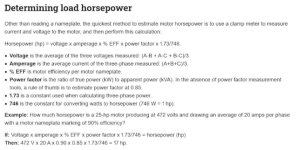andrewgreene said:
Question regarding e bike power, the controller has phase amps and battery amps, the phase amps are dependent on terrain/load if im not mistaken, which typically means your phase amps will be more than the battery amps. Now my question, if you where to dyno a bike is the power going to be consistent with the phase amps or battery amps?
Example, 72v battery, pushing 250 battery amps, 450 phase amps, would you calculate the total power with phase amps or battery amps?
Battery amps = 72v x 250 = 18kw (24hp)
Phase Amps = 72v x 450 = 32kw (43hp)
To answer your question simply (rather than e-beach'es more detailed, some would even say more 'correct' answer):
Phase amps x battery volts is a meaningless calculation. For instance, a simple 'proof' is that you cant get more power out than you put in... so 32kw out cant happen when your input is 18kw. It is useless in general though, because as ebeach explains the motor amps bares no direct relation to the battery voltage.
Battery amps x input voltage gives you your input power to the controller, and is usually pretty close to the motor input power too. It can be used as a back of the envelope measure of your motors likely performance, but does not account for things like efficiency of your controller or motor, so is a very roundabout guide, and could be off by a factor of 10 or more. Put 18kw into a little 250W motor and you wont get 18kw out, more like 1kw at best (just for an example). The rest will be heat, and that motor will burn quickly. That said, input power (battery) is regularly used as a measuring stick of a bikes performance, and is often used due to the relative ease of measuring those values (battery V and A). So long as the motor isn't massively underspec'ed as in the above example, it does give a reasonable, ballpark indication to how the motor/bike will perform.
Phase amps are due primarily to:
1.the rpm of the motor (lower enables more ph amps to potentially flow - see limits below) - thus it can be load (terrain) dependent but 'terrain' is not what actually dictates phase amps...
2.the 'size' of the controller (a bigger controller can safely transfer more current to the motor without blowing itself up)
3.the 'size' of the battery - both voltage and its output capacity (higher voltage pushes more current through the motors phase-phase resistance + inductance, at higher rpms, higher output capacity enables this without destroying the battery)
Phase amps are limited by:
-increased rpm - as the motor spins it generates voltage across its phases - this voltage is directly opposed to the battery voltage, and a 'lower' battery voltage means less current can be 'pushed' through the motor - see point 3 above.
- a motors phase-phase resistance - a somewhat fixed perimeter that will increase as the motor heats up, reducing the max potential phase amps for a given rpm.
- the controller - depending on setup, the controller will try to feed x phase amps to the motor, it is the 'brain' in the system that governs the current flow. it does this by rapidly connecting/disconnecting the battery to the motor phases (thousands of times per second), so that it limits the phase current thanks to the inductance and resistance in the motor windings/phases, and any back EMF from the motor.
phase amps determine:
-the motors output torque. up to a certain point, the motors output torque is more or less directly proportional to the phase amps. Double the phase amps, you double the torque. There are some practical limits, ie at some point the motor will 'saturate' and the 1:1 ratio will be dramatically reduced such that doubling phase amps past that point may only result in 10% more torque.
-the motors heat - heat is proportional to the phase current squared... so doubling phase current quadruples the heat generated in the motor. There are other sources of heat, but this heat (called copper losses) are often the primary source.
putting it simply - (phase A) x (motor V) = (battery A) x (battery V) = (input power).... battery V can be viewed as somewhat 'fixed' - it will sag under load but will generally vary to only a small degree compared to the other parameters. As such to balance the equation and get more phase A than you have battery A - its necessary that the motor V is less than the battery V, by a proportional amount.
All of what I've stated above is not strictly 'true'/'accurate', and leaves out some nuance for the sake of simplicity - but should give a good laymen understanding of whats going on, and how each number relates to the other. In reality there's far more to it than what said here, and the # can thus be quite different to what you'd be able to calculate with the above, but it'll get you in the ballpark for 90% of cases.



